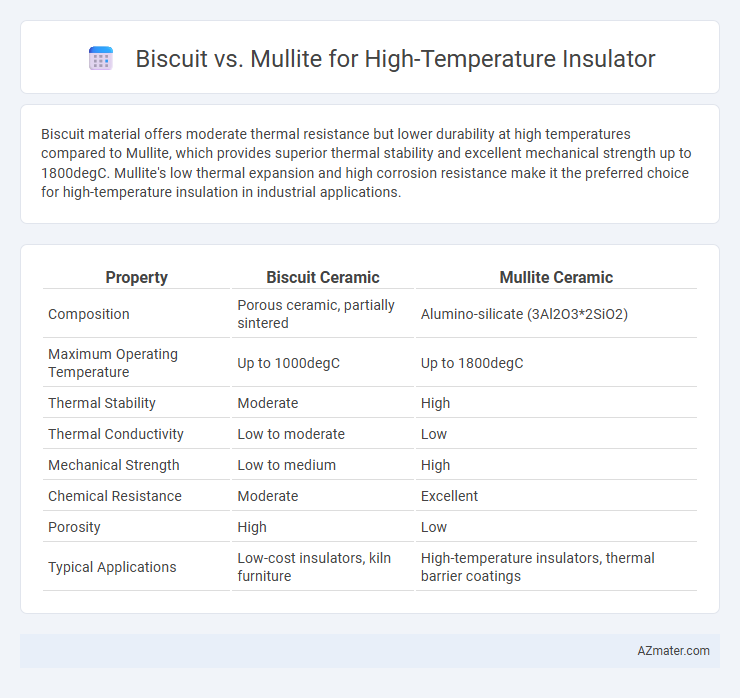Biscuit material offers moderate thermal resistance but lower durability at high temperatures compared to Mullite, which provides superior thermal stability and excellent mechanical strength up to 1800degC. Mullite's low thermal expansion and high corrosion resistance make it the preferred choice for high-temperature insulation in industrial applications.
Table of Comparison
| Property | Biscuit Ceramic | Mullite Ceramic |
|---|---|---|
| Composition | Porous ceramic, partially sintered | Alumino-silicate (3Al2O3*2SiO2) |
| Maximum Operating Temperature | Up to 1000degC | Up to 1800degC |
| Thermal Stability | Moderate | High |
| Thermal Conductivity | Low to moderate | Low |
| Mechanical Strength | Low to medium | High |
| Chemical Resistance | Moderate | Excellent |
| Porosity | High | Low |
| Typical Applications | Low-cost insulators, kiln furniture | High-temperature insulators, thermal barrier coatings |
Introduction to High-Temperature Insulators
High-temperature insulators such as biscuit and mullite play crucial roles in applications requiring thermal resistance above 1000degC. Biscuit material, typically ceramic-based, offers good insulation and mechanical strength but has lower thermal shock resistance than mullite, a silicate mineral known for its exceptional thermal stability and low thermal expansion. Mullite's unique crystalline structure provides superior durability and insulation performance in harsh high-temperature environments, making it preferable for advanced industrial furnaces and kilns.
What is Biscuit? Composition and Properties
Biscuit is a semi-fired ceramic material commonly used in high-temperature insulation applications due to its excellent thermal stability and mechanical strength. It primarily consists of kaolinite clay mixed with alumina and silica, which undergoes partial sintering to achieve hardness while maintaining porosity for thermal insulation. Biscuit exhibits good thermal shock resistance and low thermal conductivity, making it suitable for furnace linings and refractory supports in high-temperature industrial processes.
What is Mullite? Composition and Properties
Mullite is a crystalline aluminosilicate mineral primarily composed of 3Al2O3*2SiO2, known for its exceptional high-temperature stability and low thermal expansion. Its unique orthorhombic crystal structure imparts excellent mechanical strength, thermal shock resistance, and chemical durability, making it ideal for refractory and high-temperature insulation applications. Mullite's thermal conductivity ranges from 3 to 5 W/m*K, withstanding temperatures above 1700degC, outperforming traditional biscuit insulators in extreme heat environments.
Thermal Performance Comparison: Biscuit vs Mullite
Biscuit insulators exhibit lower thermal conductivity, typically around 1.1-1.3 W/m*K, providing better thermal insulation at high temperatures compared to mullite, whose thermal conductivity ranges from 3.5 to 5 W/m*K. Mullite demonstrates superior thermal shock resistance and maintains structural integrity up to 1750degC due to its unique alumina-silica crystalline phase composition. The choice between biscuit and mullite insulators hinges on balancing the need for lower heat transfer with enhanced durability under thermal stress conditions.
Mechanical Strength and Durability
Biscuit ceramic, typically made from fired clay, exhibits moderate mechanical strength but lower durability under prolonged high-temperature conditions compared to mullite. Mullite, an alumino-silicate ceramic, possesses superior mechanical strength and excellent thermal stability, making it highly resistant to thermal shock and mechanical wear in high-temperature insulator applications. The enhanced durability and fracture toughness of mullite contribute to its widespread use where long-term reliability and structural integrity are critical.
Electrical Insulation Capabilities
Biscuit insulators provide moderate electrical insulation suitable for temperatures up to 1000degC, while mullite offers superior dielectric strength and stability at temperatures exceeding 1300degC. Mullite's high resistivity and low dielectric loss make it ideal for high-temperature electrical insulation in industrial furnaces and kilns. The intrinsic properties of mullite contribute to prolonged insulation performance under thermal cycling compared to biscuit materials.
Resistance to Thermal Shock
Biscuit insulators, typically made from dense alumina, offer moderate resistance to thermal shock with limited expansion and contraction tolerance under rapid temperature changes. Mullite insulators, composed of 3Al2O3*2SiO2, exhibit superior thermal shock resistance due to low thermal expansion and high thermal stability, ideal for cyclic high-temperature applications. Their enhanced microstructural stability minimizes cracking and mechanical failure during extreme thermal gradients, making mullite preferred in high-temperature industrial insulators.
Cost and Availability Factors
Mullite offers superior thermal stability and lower thermal expansion compared to biscuit material, making it ideal for high-temperature insulation in industrial furnaces. Biscuit insulation is generally more affordable and widely available, using common ceramic materials that reduce initial costs but may require more frequent replacement under extreme conditions. Cost-effectiveness in high-temperature applications depends on throughput and maintenance cycles, with biscuit favored for budget constraints and mullite preferred for long-term performance and durability.
Applications in Industry: Biscuit vs Mullite
Biscuit and mullite are both used as high-temperature insulators in industry, with mullite offering superior thermal stability and mechanical strength at temperatures exceeding 1500degC, making it ideal for applications in kilns, furnaces, and gas turbines. Biscuit, typically composed of alumina-silicate ceramics, is preferred for moderate temperature insulation around 1000degC, often employed in industrial ovens and heat treatment processes. Mullite's resistance to thermal shock and chemical corrosion enhances its application in harsh environments, while biscuit provides cost-effective insulation for less demanding thermal conditions.
Choosing the Right Insulator for Your Needs
Biscuit insulators, typically made from porcelain or ceramic materials, offer excellent resistance to mechanical stress but have lower maximum temperature ratings around 1100degC, making them suitable for moderate high-temperature applications. Mullite insulators, composed primarily of aluminosilicate minerals, withstand higher temperatures up to 1800degC and exhibit superior thermal stability and low thermal expansion, ideal for advanced industrial furnaces and thermal insulation systems. Selecting between biscuit and mullite insulators depends on the specific temperature requirements, mechanical durability, and thermal shock resistance needed for your high-temperature application.

Infographic: Biscuit vs Mullite for High-temperature insulator
 azmater.com
azmater.com